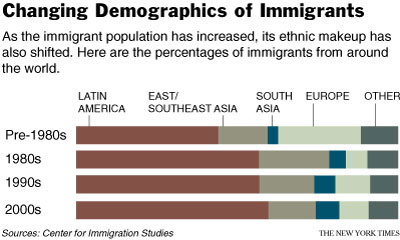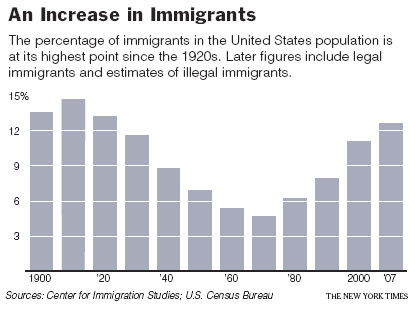| Want to send this page or a link to a friend? Click on mail at the top of this window. |
More Special Reports |
| Posted Thursday, November 29, 2007 |
| U.S. Immigrant Population |
| Is Highest Since the 1920s |
| _____________________ |
| Study Focuses on the Public Costs of Influx |
| By JULIA PRESTON |
Immigration over the past seven years was the highest for any seven-year period in American history, bringing 10.3 million new immigrants, more than half of them without legal status, according to an analysis of census data released today by the Center for Immigration Studies in Washington.
One in eight people living in the United States is an immigrant, the survey found, for a total of 37.9 million people - the highest level since the 1920s.
The survey was conducted by Steven A. Camarota, director of research at the center, which advocates reduced immigration.
Mr. Camarota has been active in the national immigration debate. Independent demographers disputed some of the survey’s conclusions, but not Mr. Camarota’s methods of data analysis.
 |
A large proportion of recent immigrants, both legal and illegal, are low-skilled workers and about one-third of those have not completed high school, giving them significantly less education than Americans born in the United States, according to the study, which is based on census data as recent as March of this year.
The survey focuses on public costs associated with the new generation of immigrant workers. It does not, however, analyze contributions they make by paying taxes and taking undesirable, low-income jobs — an omission criticized by some immigration scholars.
Still, the survey provides a panorama of the effects of immigration since 2000.
About 30 percent of all immigrants and their children lack health insurance, Mr. Camarota reports, compared with 13 percent of native-born Americans. One of every three uninsured people in the country is an immigrant or a young American-born child with at least one immigrant parent, he found. Immigrant families account for almost three-quarters of the increase in the uninsured in the past 15 years, he concludes.
 |
Immigrants are employed at higher rates than Americans, according to the survey. But because of their low educational levels, many work in low-paying, entry-level jobs that do not provide health insurance or other benefits.
“Immigrants have had an enormous impact on the lack of health insurance,” Mr. Camarota said. “If we are going to have a debate about health insurance, we should recognize that most of the growth in the uninsured comes from recently arrived immigrants and their American-born kids.”
____________ |
|
| Center pushing for less immigration uses recent census data. | |
____________ |
Mr. Camarota was criticized by some immigration scholars for failing to examine the progress immigrant families make the longer they remain and work in the United States.
“This is a one-eyed portrait,” said Dowell Myers, a demographer at the University of Southern California who has studied immigrants’ use of public services. “It is a profile of immigrants’ dependency without any profile of their contributions.”
Mr. Myers said his research shows that within a decade, new immigrants in California moved up quickly to steadier jobs with more benefits, and the rates of uninsured immigrants dropped sharply. Mr. Camarota’s analysis suggests why illegal immigration has become the source of contention in many states. The majority of immigrants arriving in recent years are from Mexico and Central America, and more than half of them are illegal.
The states that have received the largest numbers of the new immigrants are also states where immigration has been hotly debated. After five states that have been high on the immigration list for decades — California, Florida, Illinois, New Jersey and Texas — those receiving the most new immigrants included Arizona, Georgia, Maryland, Pennsylvania and Virginia.
The analysis confirms earlier estimates of about 11.3 million illegal immigrants in this country.
About 31 percent of immigrants over 25 years old, both legal and illegal, have not completed high school, according to Mr. Camarota, compared with 8.4 percent of American citizens. Among adult Hispanic immigrants, nearly 51 percent do not have high school diplomas, he reported.
____________ |
|
| 'This is a one-eyed portrait,' said a demographer critical of a report. | |
____________ |
Mr. Camarota found that about one-third of immigrant families receive some kind of public assistance. The services were mainly food stamps and Medicaid associated with care for their American children, he found. The majority of children in immigrant families, whether the parents are legal or illegal, were born in the United States and so are American citizens.
“The welfare system is designed to help low-income workers with children,” Mr. Camarota said. “The study shows that it is very difficult not to have these public costs if you have low-skilled immigrants in large numbers.”
Mr. Camarota did not present evidence of large scale use of public benefits by illegal immigrants themselves.
Wayne Cornelius, a political science professor at the University of California, San Diego, who has studied Mexican immigration for decades, called Mr. Camarota’s conclusions about immigrants’ use of public services “misleading.”
The census data, Mr. Cornelius said, does not allow concise estimates of use of public services by illegal immigrants.
Mr. Cornelius said his field research in San Diego County had shown that illegal immigrants under-used the health care system, given their health needs.
“They are less likely to have health insurance, but they are also less likely to seek medical attention,” Mr. Cornelius said.
He added that research in California has shown that illegal immigrants from Latin America are far less likely than American Hispanics to use emergency room services or seek public primary care.
Mr. Cornelius also faulted Mr. Camarota for focusing only on first-generation immigrants. The study “obscures the very significant progress that immigrants’ children and their grandchildren typically make,” Mr. Cornelius argued.
Mr. Camarota reported that both legal and illegal immigration have continued to grow. A study in 2005 by another demographer, Jeffrey S. Passel of the Pew Hispanic Center in Washington, found that the rate of growth of immigration peaked in 2000 and declined somewhat in the next five years.
Copyright 2007 The New York Times Company. Reprinted from The New York Times, National, of Tuesday, November 29, 2007.
| Wehaitians.com, the scholarly journal of democracy and human rights |
| More from wehaitians.com |